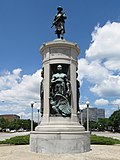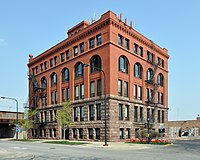Douglas, Chicago
Douglas | |
|---|---|
| Community Area 35 - Douglas | |
 Prairie Shores in Bronzeville | |
 Location within the city of Chicago | |
| Country | United States |
| State | Illinois |
| County | Cook |
| City | Chicago |
| Neighborhoods | |
| Area | |
| • Total | 1.67 sq mi (4.33 km2) |
| Population (2010) | |
| • Total | 18,238 |
| • Density | 11,000/sq mi (4,200/km2) |
| Demographics 2010[1] | |
| • White | 9.92% |
| • Black | 72.63% |
| • Hispanic | 2.55% |
| • Asian | 12.68% |
| • Other | 2.21% |
| Time zone | UTC-6 (CST) |
| • Summer (DST) | UTC-5 (CDT) |
| ZIP Codes | parts of 60609, 60616 and 60653 |
| Median household income | $32,805[2] |
| Source: U.S. Census, Record Information Services | |
Douglas, on the South Side of Chicago, Illinois, is one of 77 Chicago community areas. The neighborhood is named for Stephen A. Douglas, an Illinois politician, whose estate included a tract of land given to the federal government.[3] This tract later was developed for use as the Civil War Union training and prison camp, Camp Douglas, located in what is now the eastern portion of the Douglas neighborhood. Douglas gave that part of his estate at Cottage Grove and 35th to the Old University of Chicago.[4] The Chicago 2016 Olympic bid planned for the Olympic Village to be constructed on a 37-acre (150,000 m2) truck parking lot south of McCormick Place that is mostly in the Douglas community area and partly in the Near South Side.[5]
The Douglas community area stretches from 26th Street South to Pershing Road along the Lake Shore, including parts of the Green Line along State Street and the Metra Electric and Amtrak passenger railroad tracks, which run parallel to Lake Shore Drive. Burnham Park runs along its shoreline, containing 31st Street Beach. The community area also contains part of the neighborhood of Bronzeville, the historic center of African-American culture in the city since the early 20th century and the Great Migration.
Neighborhoods
Bronzeville
Bronzeville is a neighborhood in the Douglas and Grand Boulevard community areas on the South Side of Chicago around the Illinois Institute of Technology, VanderCook College of Music, and Illinois College of Optometry. It is accessible via the Green and Red lines of the Chicago Transit Authority, as well as the Metra Electric District Main Line. In 2011 a new Metra station, Jones/Bronzeville Station, opened to serve the neighborhood on the Rock Island and planned SouthEast Service.
In the early 20th century, Bronzeville was known as the "Black Metropolis", one of the nation's most significant areas of African-American urban history. Between 1910 and 1920, during the peak of the "Great Migration", the population of the area increased dramatically when thousands of African Americans escaped the oppression of the South and emigrated to Chicago in search of industrial jobs. The Wabash YMCA is considered the first African-American Y in the U.S.[6] It continues as a center today due to the continued support of many of the Black churches in the area.[7] The Wabash YMCA is widely credited as the birthplace of the commemoration of black culture, what would later become Black History Month.[8]
Noted people associated with the development of the area include: Andrew "Rube" Foster, founder of the Negro National Baseball League; Ida B. Wells, a civil rights activist, journalist and co-organizer of the NAACP; Margaret Taylor-Burroughs, artist, author, and one of the co-founders of the DuSable Museum of African American History; Bessie Coleman, the first African-American woman pilot; Gwendolyn Brooks, 1985 United States Poet Laureate, 1968 Poet Laureate of Illinois, and first African American awarded the Pulitzer Prize; actresses Marla Gibbs and Jennifer Beals; acclaimed R&B singers Sam Cooke and Lou Rawls; and cornet player and jazz bandleader King Oliver. His protégé, jazz musician, trumpeter and bandleader Louis Armstrong from New Orleans and his wife Lil Hardin Armstrong, who was a pianist, composer and bandleader, lived in Bronzeville on E. 44th Street and performed at many of the area's night clubs, including the Sunset Cafe and Dreamland Cafe. The neighborhood includes the Chicago Landmark Black Metropolis-Bronzeville District.[9]
47th Street was and remains the hub of the Bronzeville neighborhood. In the early 21st century, it has started to regain some of its former glory. Gone for good is the Regal Theater (demolished in 1973), where many great performers took the stage. From the 1940s and 1960s, high-rise public housing projects were constructed in the area, which were managed by the Chicago Housing Authority. The largest complex was the Robert Taylor Homes. They developed severe social problems exacerbated by concentrated poverty among the residents and poor design of the buildings. This project was demolished in the late 1990s and early 21st century. The nickname "Bronzeville" was first used for the area in 1930 by James J. Gentry, a local theater editor for the Chicago Bee publication. It refers to the brown skin color of African Americans, who predominated as residents in that area. It has become common usage throughout the decades.[10]
Bronzeville and its Black community have a central role in the plot of Sarah Paretsky's 2003 detective mystery novel Blacklist, part of the V. I. Warshawski series.
Prairie Shores
Originally a five-building, 1677-unit public housing project erected in 1962 by Michael Reese Hospital, Prairie Shores has been adapted as a market rate, middle-class community. Along with the adjacent Lake Meadows development, this was part of the city's largest urban renewal project at the time of its inception in 1946. The total project included construction of the Illinois Institute of Technology and Mercy Hospital. The development was funded under the Title I of the Housing Act of 1949, using US$6.2 million ($62.5 million today) of subsidies.[11]
Groveland Park
Of all the sections of Douglas originally developed by Stephen A. Douglas, only Groveland Park survives. Its homes are built around an oval-shaped park. Groveland Park is located between Cottage Grove Avenue, 33rd Street, 35th Street and the Metra Electric railroad tracks.
Demographics
| Census | Pop. | Note | %± |
|---|---|---|---|
| 1930 | 50,285 | — | |
| 1940 | 53,124 | 5.6% | |
| 1950 | 78,745 | 48.2% | |
| 1960 | 52,325 | −33.6% | |
| 1970 | 43,731 | −16.4% | |
| 1980 | 35,700 | −18.4% | |
| 1990 | 30,652 | −14.1% | |
| 2000 | 26,470 | −13.6% | |
| 2010 | 18,238 | −31.1% | |
| [12] | |||
Education
The following Chicago Public Schools campuses serve Bronzeville: Beethoven School, Phillips Academy High School, Dunbar Vocational High School, Bronzeville Scholastic Institute, Chicago Military Academy, Walter H. Dyett High School, and De La Salle High School are within this community.
Bronzeville is also home to the renowned Illinois Institute of Technology, which is famous for its engineering and architecture programs. It is home to the VanderCook College of Music and the Illinois College of Optometry. In 2006 the liberal arts school Shimer College, based on the Great Books, moved into the neighborhood.
The Bronzeville / Black Chicagoan Historical Society is a not-for-profit educational and African-American heritage organization formed to celebrate, provide information, and encourage preservation of black life and culture of Chicago. The organization was founded in 1999 by Sherry Wiliams and other members from the community. Additionally, the organization is committed to community programs, projects and events.[13]
See also
References
- ^ Paral, Rob. "Chicago Demographics Data". Retrieved 12 June 2012.
- ^ Paral, Rob. "Chicago Census Data". Retrieved 9 October 2012.
- ^ Callary, Edward (29 September 2008). Place Names of Illinois. University of Illinois Press. p. 97. ISBN 978-0-252-09070-7.
- ^ [1]
- ^ Hinz, Greg (2006-09-23). "Plan for 2016 Olympics disclosed". Crain Communications, Inc. Retrieved April 2, 2007.
- ^ "Wilton YMCA", Official Website
- ^ [2]
- ^ University of Chicago collections
- ^ "Black Metropolis-Bronzeville District". City of Chicago Department of Planning and Development, Landmarks Division. 2003. Retrieved 2007-05-10.
- ^ "Bronzeville Stories".
- ^ Garvin, Alexander (2002). The American Dity: What Works, What Doesn't. McGraw-Hill Professional. p. 167. ISBN 0-07-137367-5. Retrieved 2010-07-04.
- ^ Paral, Rob. "Chicago Community Areas Historical Data". Chicago Community Areas Historical Data.
- ^ [3]




